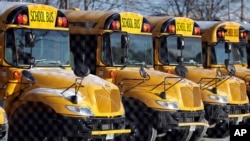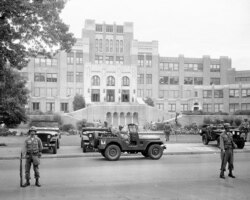The first Democratic presidential debate for the 2020 elections brought a decades-old civil rights issue back into the public spotlight: whether to bus children to racially integrate schools.
One of the most defining moments of the debate came when U.S. Senator Kamala Harris challenged former Vice President Joe Biden's record for not supporting the type of busing that she experienced as a black schoolgirl in California.
The exchange garnered headlines and brought the topic of busing, which had been a national issue in the 1970s but had largely fallen out of the public conversation, back into the spotlight.
What is busing?
Busing was a tool that many U.S. communities used to overcome racial segregation in public schools.
Following the 1954 U.S. Supreme Court ruling in Brown v. Board of Education, legal racial segregation in schools was outlawed across the United States. However, because of demographic trends and housing policies, many U.S. neighborhoods remained segregated, and as a result schools were effectively segregated because students attended schools in neighborhoods where they lived.
In the late 1960s and throughout the 1970s, courts ruled that local jurisdictions were not doing enough to promote desegregation in schools and began mandating busing to address the problem. Federal agencies oversaw and enforced busing efforts, including collecting data about the race of students and withholding money from noncompliant schools.
Who was bused?
Both black students took buses to majority-white schools and white students to majority-black schools in court-ordered busing.
However, Brett Gadsden, the author of a book about desegregation efforts in Delaware, "Between North and South: Delaware, Desegregation, and the Myth of American Sectionalism," said, “African American students disproportionally shouldered the burden” of efforts to desegregate schools.
Gadsden, an associate professor of history at Northwestern University, said black students were forced to travel longer distances and for many more years than white students.
Why was it controversial?
Busing proved to be intensely controversial nationwide. Supporters argued busing was necessary to integrate schools and to give black and white students equal access to resources and opportunities.
Critics argued that busing was dangerous and costly, and many parents did not want their children to have to travel great distances to get to school.
While much of the opposition to busing came from whites, the black community was also divided about its merits.
Gadsden said black critics cited the burden their children had to shoulder in terms of distance traveled and time spent on buses. They also complained that historically black schools were closed, and black administrators and teachers lost their jobs as a result of busing policies, while similar demands were not made of white schools, Gadsden said.
In Boston, anti-busing protests turned violent in 1974, with demonstrators throwing bricks and bottles at school buses.
Political analyst Larry Sabato of the University of Virginia said in a Twitter post following the Democratic debate that busing was so unpopular in the 1970s that Democrats running for office often had a choice to “be a profile in courage and lose, or oppose busing in whole or in part & win to fight another day on stronger ground.”
Biden’s stance
During the 1970s when Biden was a freshman U.S. senator representing Delaware, he worked with conservative senators to oppose federally mandated busing.
In a 1975 interview with a Delaware newspaper that was first resurfaced by The Washington Post, Biden said, “I do not buy the concept, popular in the ’60s, which said, ‘We have suppressed the black man for 300 years and the white man is now far ahead in the race for everything our society offers. In order to even the score, we must now give the black man a head start, or even hold the white man back, to even the race.’”
During the Democratic debate, Biden defended his position against mandated busing in the 1970s, arguing that he did not oppose voluntary busing by communities, only federal mandates. “I did not oppose busing in America; what I opposed is busing ordered by the Department of Education,” he said.
Harris responded by saying the federal government needed to be able to step in and mandate busing in some areas because “there was a failure of states to integrate public schools in America.”
Schools today
While some communities still champion voluntary busing measures, most busing efforts ended by the turn of the century. Local and national court rulings in the 1990s said many communities had succeeded in improving the integration of their schools and allowed busing programs to end.
The Civil Rights Project at UCLA said in a May report to mark the 65th anniversary of Brown v. Board of Education, that segregation in schools is again on the rise and has been growing “unchecked” for nearly three decades, “placing the promise of Brown at grave risk.”
The report said white students, on average, attend a school in which 69% of the students are white, Latino students attend schools in which 55% of the students are Latino, and black students attend schools with a combined black and Latino enrollment averaging 67%.
Gadsden agreed there is “a lot of segregation in schools now” but said there is little political will to go back to the era of busing. “Federal courts now are not particularly sympathetic to challenges to school segregation,” he said, also noting there is no great appetite in the U.S. Congress to introduce measures to advance school desegregation.
After the debate, Harris told reporters that "busing is a tool among many that should be considered.” however, when pressed on whether she supported federally mandated busing today, she said she would not unless society became as opposed to integration as it was in the 1970s.
Some critics say Harris' position on busing today is not that much different from Biden's.











